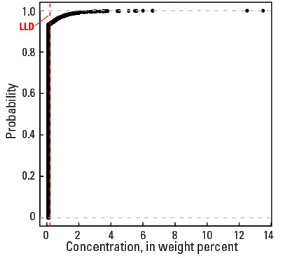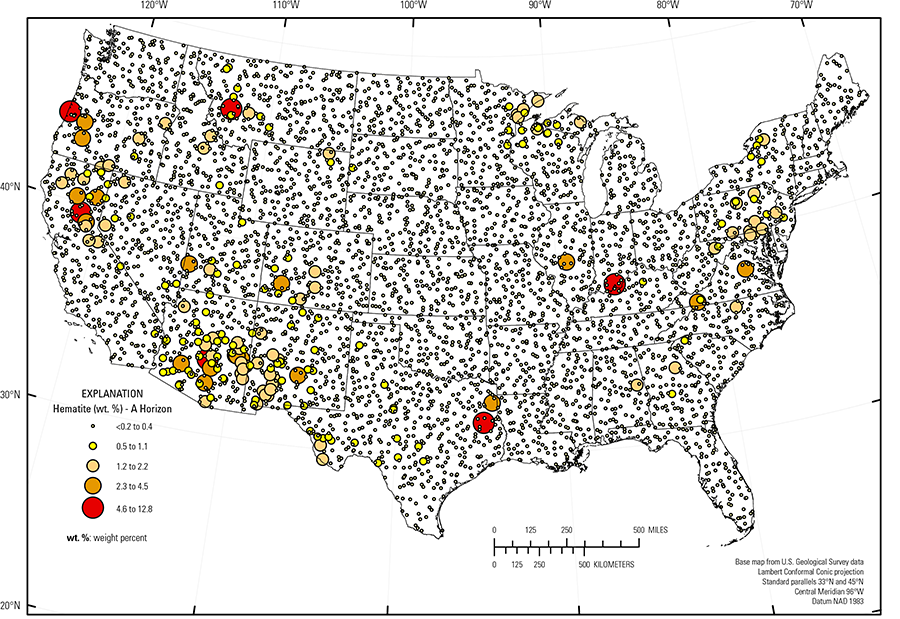
The purpose of these interpretive discussions is to provide a perspective on regional- and national-scale variations in element and mineral distributions in soils and their likely causes. The significant spatial variations shown by most elements and minerals can commonly be attributed to geologic sources in underlying parent materials, but other spatial variations seem clearly related to additional factors such as climate, the age of soils, transported source material, and anthropogenic influences. We attempt to distinguish the influence of these various factors on a regional and national scale. Numerous more local features might similarly be related to these same factors, but these features also have some probability of being an artifact of a random sampling of variable compositions, so that there is some probability of samples with similar compositions occurring in clusters of two or more adjacent sites by chance. Distinguishing such random occurrences from true variability is beyond the scope of the data from which these maps are constructed. Some caution, therefore, is advisable in interpreting the significance of these more local features unless some unique sources or processes can clearly be related to them.
Hematite is an iron (Fe)–oxide mineral with a chemical formula of Fe2O3 that is present in a wide variety of soils. Hematite in soils can be inherited from soil parent materials or form directly in soils by oxidation of iron–bearing minerals. Hematite is a common mineral in intensely weathered soils in warm and humid climates. Iron oxides in soils are strong coloring agents. Redness in soils has been shown to correlate with hematite concentration.
Hematite is mined as an Fe ore mineral along with magnetite. Statistics and information on the worldwide supply of, demand for, and flow of Fe ore are available through the U.S. Geological Survey (USGS) National Minerals Information Center (NMIC) website.
In our data, hematite is present in only about 6 percent of the 4,773 soil C horizon samples, and in slightly more than 5 percent of the 4,802 soil A horizon samples,(see the summary statistics [open in new window]). In all soils, hematite may be more common at concentrations below the detection limit of 0.2 weight percent (wt. %). Because so few samples have hematite concentrations above the detection limit, the spatial distribution of hematite is shown as a proportional symbol map rather than an interpolated and smoothed color surface map. The distribution of hematite in both soil horizons are somewhat similar, suggesting similar sources.
Hematite in the soil C horizon has a maximum value of 13.5 wt. %, measured for a site in eastern Texas developed on residual red sandstone. Similarly, soils in the western Lake Superior region (eastern Minnesota, northwestern Wisconsin) developed on glacial deposits sourced from hematite–bearing Precambrian red sandstones. In these settings, hematite was likely inherited from parent materials. Throughout the West, soils with detectable hematite developed on residual volcanic rocks or on alluvium derived from volcanic rocks (for example, southern Arizona , western New Mexico, southern Utah, and the Rocky Mountains in Colorado and Montana). In the Piedmont (Fenneman and Johnson, 1946), intensely weathered soils contain hematite, likely the result of weathering of primary Fe–bearing minerals. At many sites in the Piedmont (Fenneman and Johnson, 1946), where hematite concentrations are higher in the soil C horizon than in the soil A horizon, the deeper soils are more clay–rich (typically aluminum (Al)–rich kaolinite), and the surface soils are sandier and quartz–rich.
Statistics - 0 TO 5 CM
Statistics - A Horizon
| Number of samples | 4,802 |
| LLD | 0.2 wt. % |
| Number below LLD | 4,534 |
| Minimum | <0.2 wt. % |
| 5 percentile | <0.2 wt. % |
| 25 percentile | <0.2 wt. % |
| 50 percentile | <0.2 wt. % |
| 75 percentile | <0.2 wt. % |
| 95 percentile | 0.4 wt. % |
| Maximum | 12.8 wt. % |
| MAD | |
| Robust CV |
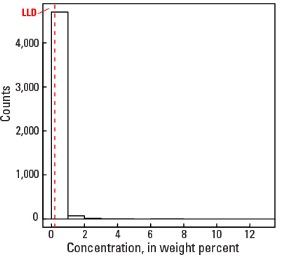
Histogram
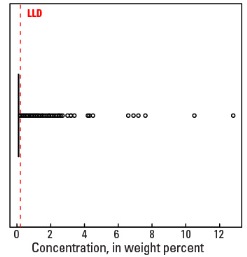
Boxplot
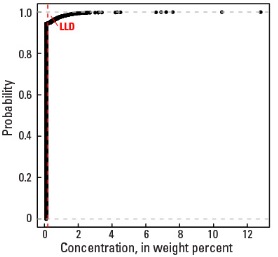
Empirical cumulative distribution function
Statistics - C Horizon
| Number of samples | 4,773 |
| LLD | 0.2 wt. % |
| Number below LLD | 4,457 |
| Minimum | <0.2 wt. % |
| 5 percentile | <0.2 wt. % |
| 25 percentile | <0.2 wt. % |
| 50 percentile | <0.2 wt. % |
| 75 percentile | <0.2 wt. % |
| 95 percentile | 0.5 wt. % |
| Maximum | 13.5 wt. % |
| MAD | |
| Robust CV |
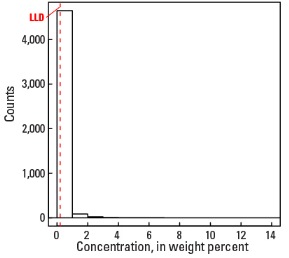
Histogram
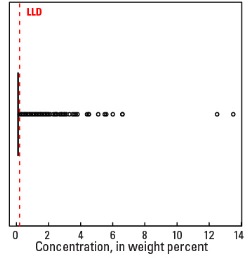
Boxplot
